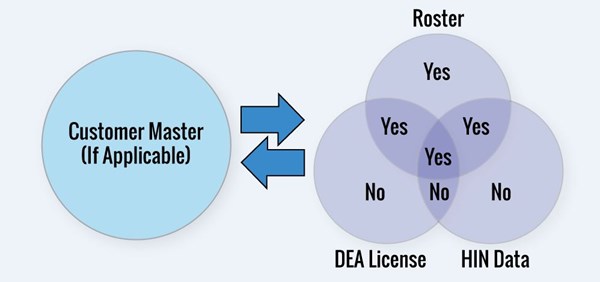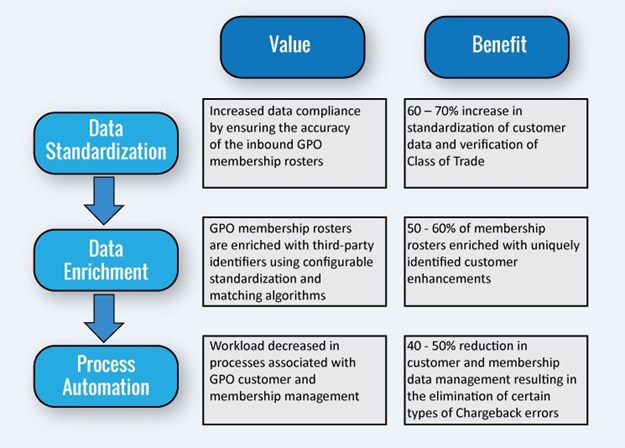The Potential Of Automated Membership Management
By: Ryan McKinney, Director of Government Pricing, and Mitesh Ghia, Senior Consultant, Alliance Life Sciences Consulting Group
Proper management of membership data poses a significant operational challenge for pharmaceutical manufacturers. Membership data is submitted by wholesaler, distributor and Group Purchasing Organization (GPO) customers in the form of “rosters” that are used by manufacturers to determine eligibility for contract sales when adjudicating chargeback and rebate transactions. Membership data also serves a second -- and equally critical purpose -- to assist manufacturers in designating customer trade class for use in regulated price reporting and sales and marketing activities.
The first challenge in managing membership data is addressing the overwhelming volume of data received. Most often, rosters are sent via email to a processing specialist in the contracts and/or chargeback processing area. A full listing is provided at the inception of the contract, and then updates detailing additions, changes and deletions to the listing are provided on a periodic basis, typically monthly. The data then has to be aggregated, cleansed and added to the company’s customer master before it can be used to process transactions. Even if the member has been previously recorded in the customer master, the accuracy of assignment cannot be guaranteed because a change or deletion may have been submitted by a wholesaler, distributor or GPO client for the current reporting period.
To lend perspective on the volume of members (and corresponding data), take for example a recent study published on GPO membership. According to Becker’s Hospital Review, September 2010, the five largest GPOs including Novation, Amerinet, Premier, Broadlane and MedAssets, experienced recent growth in membership, totaling over 232,000 members on a combined basis. Most pharmaceutical manufacturers will contract with several, if not all, of these major GPOs. Now add to that number the total members of the wholesaler and distributor sales channels, and it is not unreasonable to expect that total membership will exceed 200,000 to 500,000 for the average manufacturer.
In addition to the sheer volume of data, another key challenge relates to the quality of data received. Most often the membership data is submitted in mixed electronic formats and contains only a handful of core elements. The data includes unique identifiers, such as DEA and HIN numbers, accompanying demographic data elements, such as class of trade, mailing address and contact information. In many cases a manufacturer will receive membership information for the same entity across two or more rosters.
Given the potential for data inconsistencies, the most critical challenge is mitigating the compliance risk associated with the use of membership data for regulated price reporting purposes. When preparing calculations, manufacturers are required to use all data available during the reporting period to provide their best estimate for each required price type. Currently there are a myriad of third-party proprietary data sources available to support validation, including the HIN database, the DEA CSA database, the Hayes Directory, the NPI database and the PHS covered entity database to name a few. Given the prevalence of these third-party proprietary data sources, it begs the question as to whether third-party data validation is not just the industry best practice, but perhaps is an “unwritten requirement” for manufacturers.
Opportunities for Data Standardization, Data Enrichment and Process Automation
To address these key challenges there are several steps that a manufacturer can take to improve process efficiency and increase consistency and accuracy of their membership data. These steps include data standardization, data enrichment and automation of membership validation procedures.
Data standardization is the process by which the membership data received is transformed into a standardized format so that it may be used for comparative purposes. As part of the process, definitions of trade class are cross-walked between the various rosters and third-party data. Development of the crosswalk needs to begin with the manufacturer’s trade class policy and definitions for assignment, which are then aligned on a one-to-one, or one-to-many relationship with the trade classes reported in the rosters and third-party data.
After the data has been standardized it can be enriched to marry all unique and third-party identifiers across all of the membership data sources. This will ensure that each entity is only counted once (a duplicate may occur for instance when the same member is identified on one roster by DEA number, and on a second by HIN). More importantly, data enrichment yields the most robust data as it tells the whole story about a given member and allows the user the ability to quickly compare all aspects reported for a specific member.
Process automation represents the greatest opportunity. By automating the review and assignment of inbound data, a manufacturer can avoid manual miss-assignments and significantly reduce the manpower and time required to process the data.
Figure 1: Utilizing an automated process to develop business rules to identify which designation matches the third-party data versus those that require further manual review.

Potential Value of an Automated Process
In response to a complicated and labor intensive process such as membership management, automation can provide business benefits from many different perspectives.
Streamlining the cleansing and matching processes of customer data from both an in-house membership source system, and external data feeds, ensures that membership data is accurate, up to date, consistent and holds true integrity. Automated data standardization increases compliance by ensuring the accuracy of the inbound GPO membership rosters, and matching the roster information across the entire spectrum of third-party feeds. This provides a benefit to manufacturers in that customer data is consistent across the board, including the verification of trade class.
The added value from such automation can provide a 50 – 60 percent increase in data enrichment with uniquely identifiable customer enhancements that help the business to build out a more robust and comprehensive customer profile supporting future business insights. This significantly decreases the volume of errors resulting in organizational revenue leakage.
Process automation will also decrease the workloads associated with membership management. Membership management consists of two major components: 1) demographic verification and 2) Class of Trade validation. Streamlining the process of verifying these two attributes allows for a 40 – 50 percent reduction in manual membership data management. This ultimately results in the elimination of certain types of chargeback errors and curtails revenue leakage. Since Class of Trade is also fundamental to regulated price and financial reporting, it’s beneficial for manufacturers to fix these errors in a proactive manner that is cost effective and consistent to ensure compliance.
Table 1: The following illustration shows a value and benefit analysis of all three of these vital components.

Key Considerations and Recommendations
Automating membership data management significantly reduces the error prone manual effort and directly increases profitability margins. The additional time that is conserved due to the automation can be realigned to higher value processes throughout the organization. Automation also provides the ability to enrich membership data with unique identifiers for accurate and comprehensive customer profiles. This further ensures accuracy in Class of Trade verification that would otherwise take countless hours of manpower, and reduces compliance risk through the standardization. Although automation will not fix 100 percent of membership problems, it will certainly assist in controlling the process while still allowing minimal human intervention when needed, thereby increasing the time, labor and cost effectiveness of resources.
Ryan McKinney has over seventeen years of professional experience in providing advisory services to the healthcare and Life Sciences industry in all aspects of regulatory and corporate compliance, operational improvement, investigations and complex litigation. Ryan serves as the Director of Government Pricing for Alliance Life Sciences, and is responsible for all GP services delivered to clients in the Life Sciences industry.
